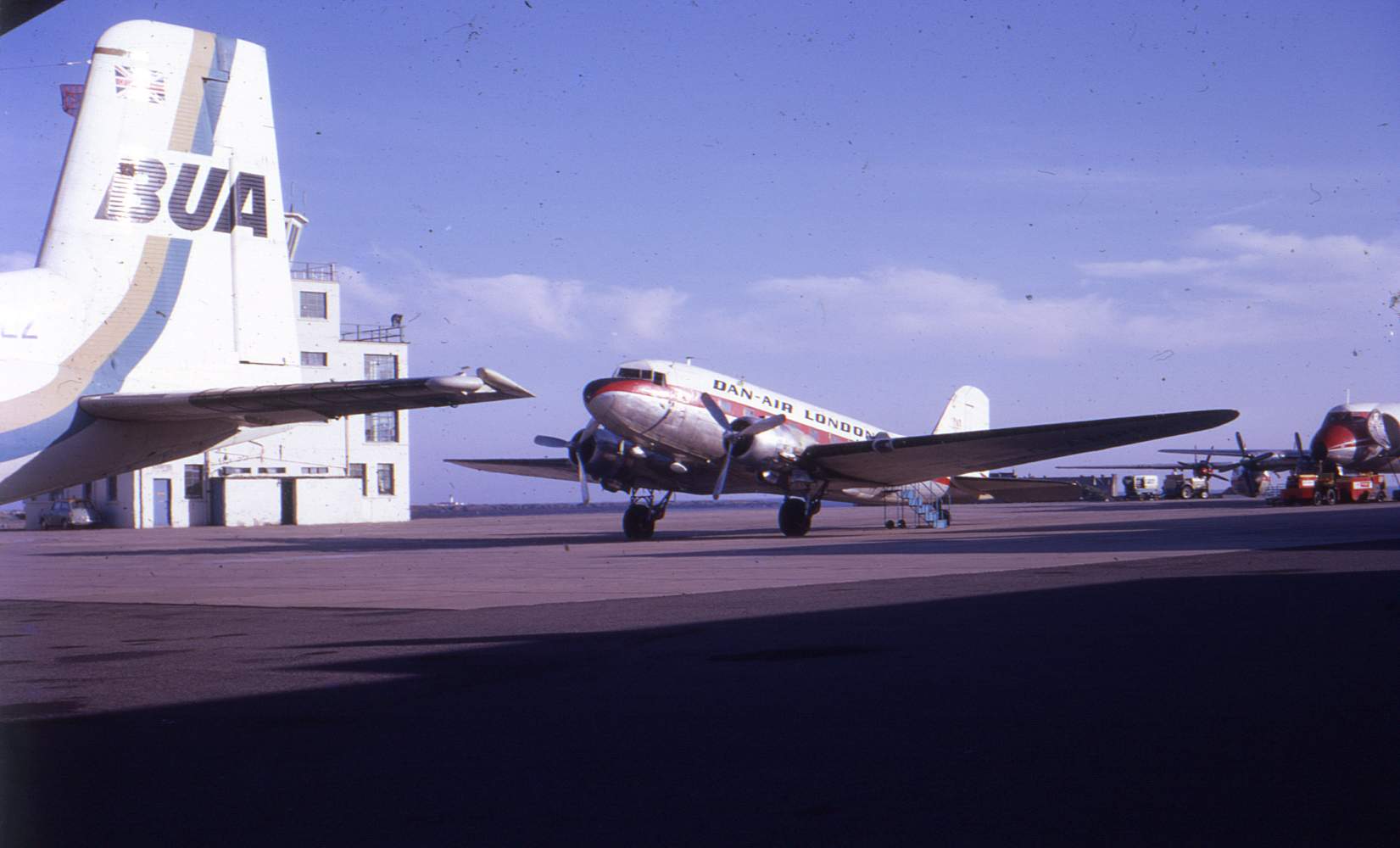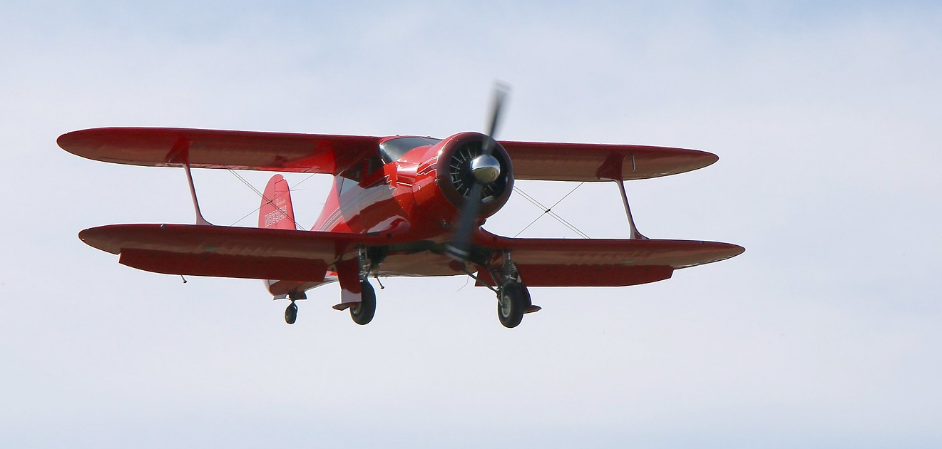
THE GROWTH OF EARLS COLNE AS A CENTRE FOR LIGHT AVIATION 1980s to THE PRESENT DAY.
The succession of visits by small private aircraft in the early 1970s led to the restitution of a grass airstrip alongside the slim remains of original runway 07/25. Soon, several light planes were spending longer periods of time at Earls Colne. Piper Colt G-ARNK, Cherokee G-AZGM and the Rallye G-AZNJ from Andrews Field were all frequent tenants of the airstrip and an ex-military Chipmunk, still in the RAF raspberry ripple colour scheme, spent some time at the western end of runway 07/25 during the mid-seventies.
The full airfield site remained mostly an arable farm although Eric Hobbs began growing strawberries and other fruit in a field close to the old Hungry Hall Farm on Coggeshall Road. The Hall had been torn-down, a new bungalow built to service the pick-your-own business and a start made on converting the classic black wooden ship-lap barns into a stylish modern house. The track which led from Coggeshall Road to the perimeter track via Hungry Hall was reconstituted with a layer of hoggin and the old pill box fortification behind the Hall was soon surrounded by a sea of soft fruit: raspberries, gooseberries, strawberries and blackcurrants.
Even in the late seventies, it was apparent that traditional arable farming was prone to not just the vagaries of the weather but also to the unpredictability of trade, retailing and politics. As this applied to the soft fruit business as much as to grain cultivation, diversification was appealing and Earls Colne airfield offered several options. First of all there was the aviation function: it was apparent that private fliers found the airstrip agreeable despite the lack of facilities. Secondly, there was an option for storage and light industry and, thirdly, there was scope to establish recreational facilities.
Eric Hobbs had done his National Service in the RAF and seemed amenable to further growth of aviation. However, the licensing and management of light flying would require some specialist input. The dawn of the eighties saw a keen group of private fliers using Earls Colne and, of these, businessman Mick Manders stepped forwards to lead the establishment of aviation facilities. He was locally-based with interests in the construction and infrastructure industries and owned a light aircraft which he regularly flew from Earls Colne. He formed Bulldog Aviation on the last day of 1981 and soon began to expand the facilities with the addition of a small hangar on a section of the old main runway adjacent to the junction of the three original concrete runways. While the airstrip remained the same, rather soft, grass strip, the hard taxiway alongside it and a hard taxiway to the Bulldog hangar along the remaining section of runway 01/19 remained extant. A very basic building was constructed to accommodate the radio room/ control tower and a pilots recreational area (30). The line of final approach was delimited by a series of markers on poles erected to the north of Richard’s Grove to guide landing aircraft over Curds Road and onto runway 07/25 on a 250 degree heading.
(30) The original WW2 Control Tower was converted into a private house post war and was demolished in 2003.
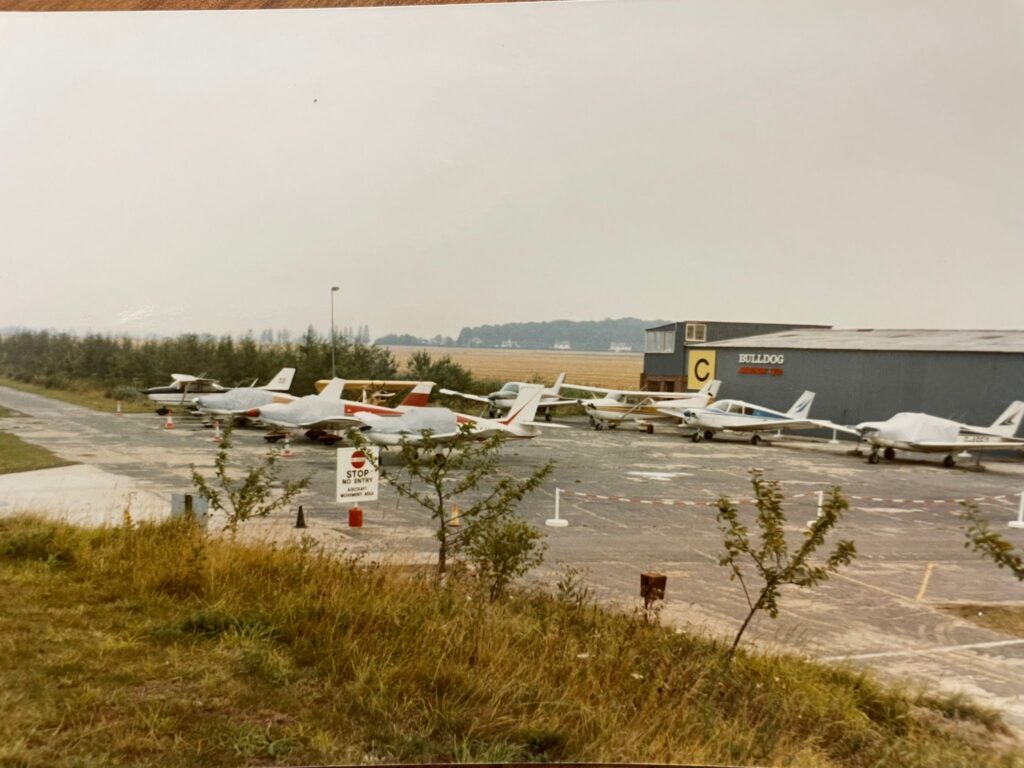
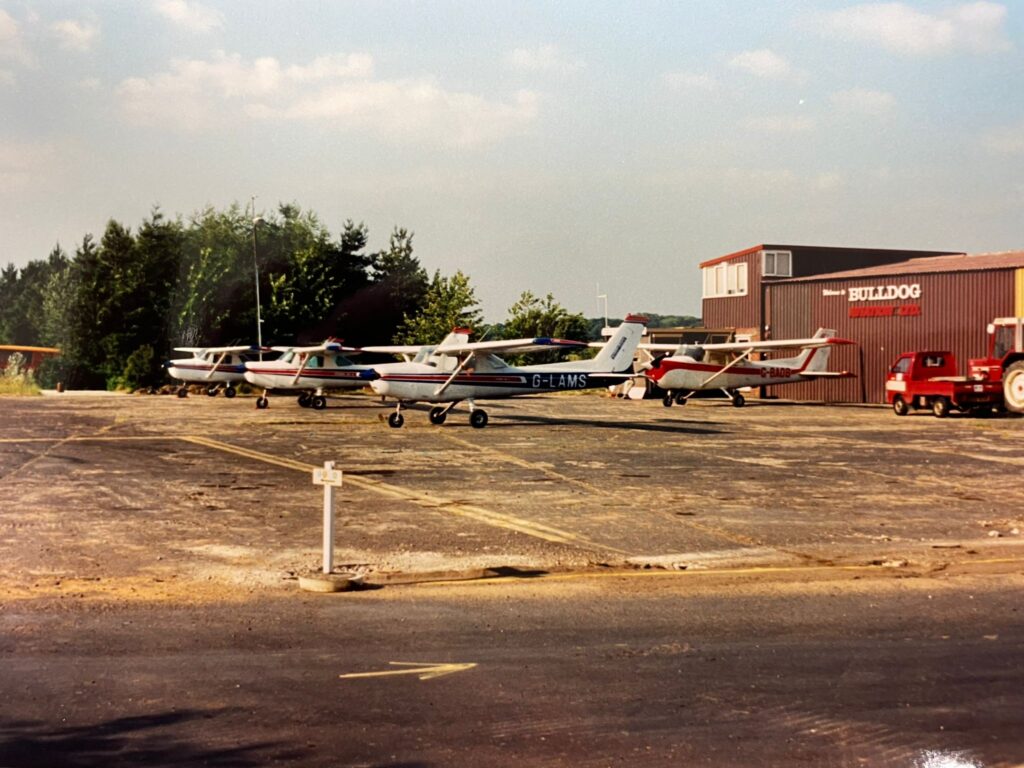
Mick Manders formed the Essex Flying School in March 1988 and flying instruction expanded along with facilities for visiting aircraft. This didn’t please all the residents of Earls Colne and householders from Coggeshall Road and Curds Road voiced their irritation with the continual circuits performed by flying school aircraft. The village Parish Council met with Mick Manders but, ultimately, the Council could see that the airfield’s industrial functions were becoming increasingly important to Earls Colne. The routing of flights was examined and a set of noise-reduction measures established. These have been maintained to the current day.
The second development option for the airfield had been storage and light industry. Initially, it was the ex-military buildings which were utilised. C.A.Blackwell (Contracts) owned the eastern hangar and Eric Hobbs had bought the second T2 hangar as an additional purchase when he acquired the airfield. Located alongside his new Honeywood Farmhouse, it served as a grain store and vehicle parking area although a large proportion was let to the agricultural service United Sack Company at a profitable rent. There were several other huts and sheds still in place and, when a local timber construction company enquired about premises, a vacant Nissen hut was rented to them. C.R.Timber was a manufacturer of roof trusses and the space and accessibility afforded by the airfield benefited their business. Clearly, there was scope for more development of light industry and storage and the construction of new warehouse buildings was commenced. Initially, these were for agricultural users but, subsequently, more diverse tenants arrived. In the early eighties, the UK arm of International Harvester took over a newly-built potato store and adapted it to become their retail headquarters. In 1985, they were followed by Milbank flooring who took-on an 8 acre site for making concrete flooring beams and panels. The manufacturing process was rather noisy and dusty and the airfield site proved less controversial than an earlier metropolitan location. The arrival of Milbank also produced a spin-off: Milbank Trucks was formed in 1986 to transport the Company’s concrete products. Over the years, it expanded under the leadership of one of the original drivers, David Watson, and diversified into new specialities. The transport function at one time operated 115 trucks and was bought-out from the Milbank Group when the latter went into a brief period of financial administration following the 2008 ‘Credit Crunch’. The Company operates today as David Watson Transport from a base near Brandon in Norfolk. Other operations which moved to the airfield in the mid eighties included the baby food/ tinned fruit company, Gerber, and a business which fitted-out ‘super yachts’. The steady development was threatened in April 1986 when a catastrophic fire ignited in the Farm’s potato store which was adjacent to Gerber’s warehouse. The store contained an LPG-powered forklift and the gas cylinder exploded through the wall into Gerber’s facility during the fire. The food warehouse was burnt out along with two million pounds worth of stock. At the peak of the blaze, over 160 firemen and 25 fire engines fought the inferno. Subsequently, Gerber’s insurers launched a five and a half million pound law suit against Hobbs Estates alleging negligence. With only one million pound’s cover in place, the airfield’s owner was facing bankruptcy which would have stalled future development on many fronts. The court case was eventually settled in 1991 with much of the blame for the disaster attributed to the use of, supposedly, non-flammable PVC insulation foam – an early indicator of future problems. Confidence in the long-term future of the industrial park returned and planning for further development was sympathetically reviewed by Braintree District Council. By 2006/ 2007, the full airfield site was employing around 1400 and had easily become Earls Colne’s largest work site (31).
(31) Figures from ‘The Life Story of an Essex Boy’ by Eric Hobbs, 2013.
The third category for development of the former airfield involved recreational pursuits. Eric Hobbs had identified golf courses as a potential growth area and saw that the wide-open prairie of the airfield could be adapted for golfing purposes. His initial venture involved the relatively straightforward development of a driving range. This proved to be a major success and four and a half million pounds funding was sought for a full eighteen-hole course, nine-hole course and club facilities. This ambitious project was obviously more capital intensive than the other undertakings and slower to yield an income. Work commenced on construction in 1989 and the course and clubhouse opened on May 1st 1991. Although the course proved popular on an initial pay-and-play basis, the popularity of the clubhouse led to the establishment of the Earls Colne Golf and Country Club. The demands of promoting and managing the facility led to Hobbs Estates deciding to lease-out the course. After initial discussions with US operators American Golf, the lease was sold to the deeply controversial entrepreneur Eddy Shah who renamed the Country Club ‘The Essex’. After five years, Shah sold the lease on to a golf-operating company called Club Haus. They had financial problems and, following insolvency, the tenancy passed to Legal and General Investments and, after a couple of years, to Irish Investment house The Club Company. They continue to run the course, the Club and have developed the gym, tennis and hotel facilities. The estate was finally able to pay-off the bank loans in 2011 and the recreational function of the airfield can be considered to be in good order.
With the sports facilities growing apace and the light industry very successful, could aviation also develop as a growth pole? The leisure aviation scene offered the possibility of expanding maintenance, tutoring and heritage functions…..

YAK TALES AND VAPOUR TRAILS
The development of heritage aviation.
Exciting airfield residents which would both delight and irritate the local population were the YAK 11 training aircraft brought to Earls Colne by Essex Double Glazing millionaire Eddie Coventry. The ASh-21 air-cooled radial engine delivered the noisy excitement of an earlier age and some interesting personalities, such as Tubeway Army frontman Gary Numan, joined Eddie in his enjoyment of the aircraft’s aerobatic abilities.
Les Briggs and Eddie Coventry had started making double-glazed windows for their own houses back in 1966 in metropolitan Essex. The business grew to become BAC Windows with a factory on Eastern Avenue in Romford. The rapid expansion of the Company enabled Eddie Coventry to take-up an interest in aviation and he acquired a CAP10 two-seater aerobatic aircraft, G-BLVK, in March 1985. The aircraft was registered in the name of BAC Aviation (what’s in a name?) and Eddie kept the red and blue craft for over 30 years. During this period, he also developed a keen interest in historic aircraft – an even more expensive pastime!
The eighties and nineties saw many air forces divesting themselves of piston-engined trainers such as the Harvard, Chipmunk and the Russian-designed YAK 11. The Egyptian Air Force had purchased Czech-built YAKs since the 1950s but, by the early eighties, they were redundant and over forty of them were lying virtually derelict at the El Aakha military base. French enthusiasts Jean Salis and Alain Capel negotiated the purchase of the entire batch and started shipping them to France by sea in June 1983.
Eddie Coventry bought YAK serial # 171205, Egyptian Air Force identity 705, and had it shipped to the UK where it was restored at Audley End/ Earls Colne between February 1988 and its first flight on 18th November 1990. He regularly flew the YAK 11 from Earls Colne as did synthpop maestro Gary Numan. Gary owned Noorduyn AT-16 Harvard G-AZSC having put in a good number of hours in larger historic aircraft – notably in the right hand seat of Air Atlantique Dakotas. He purchased the Harvard in February 1984 and flew in it as part of the five-aircraft Harvard Formation Team during 1988. It was painted in a white Mitsubishi Zero/ Tora Tora Tora colour scheme for many years and flown very competently by Gary at many airshows. He also flew the Harvard as half of the ‘Radial Pair’ display combo. It seems likely that he visited Earls Colne in the Harvard – he certainly performed some very spectacular aerobatic routines in YAK G-OYAK at the airfield including an impromptu display during a 1992 commemoration of 323rd BG operations. He is also credited with extinguishing the Flying Club’s barbeque during a low pass in the YAK.
Eddie Coventry owned ‘OYAK until 21st April 1998 when it was sold to ex-BAF Herald pilot Angie Soper, already the part-owner of a Harvard and later the operator of a YAK 50 and YAK 52. Eddie Coventry’s investment in historic aircraft was also helping to promote a synergy between aero engineering companies in rural East Anglia, in particular Earls Colne and Audley End. In 1988, the RAF was selling-off five ‘gate guardian’ Spitfires and Eddie bought Spitfire XVIE TD248 which had been sitting outside RAF Sealand in North Wales. The restoration was entrusted to Tim Routsis’ company Historic Flying Limited and they received the Spitfire by truck in October 1988. HFL amalgamated with another restoration organisation, Vintage Fabrics, which had been formed in 1986 at Audley End from the Ragwing company. Vintage had moved to a workshop at Rayne near Braintree but now moved back to a purpose-built hangar at Audley End in preparation for the Spitfire work. While HFL remained at Audley End, the Vintage Fabrics brand was moved to Earls Colne in 1997 by owners Clive and Linda Denny. They operated a busy workshop at Colne and completed many projects in association with Hawker Restorations. Most recently, they have returned to Audley End in 2007 after a brief spell working in Braintree.
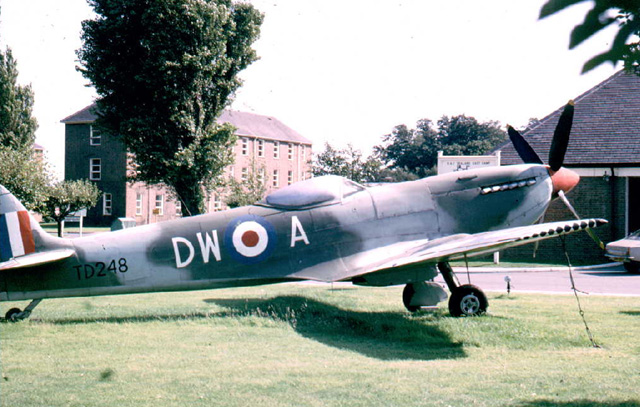
Eddie Coventry’s Spitfire was registered to BAC Aviation as G-OXVI on 22nd August 1989 but only managed its first flight on 10th October 1992. ‘VI visited many airshows with Eddie but spent a lot of time at Earls Colne too. It was painted in the highly original red and silver RAF racing colours with ‘The FB’ (best not to ask) painted in yellow on the port canopy frame. It remained part of the Coventry stable until sold in April 1996 to Karel Bos, by then the owner of Historic Flying Ltd. Today, she does her flying from Duxford.
During the early 90s Eddie Coventry added another ex-Egyptian YAK 11 to his collection: G-IYAK, s/n 171103. It was registered in his name on January 12th 1994 and restoration was commenced at Earls Colne with Vintage Fabrics and Hawker Restorations. It made its first flight in January 2000 and stayed with Eddie Coventry until sold to Glyn James in May 2005.
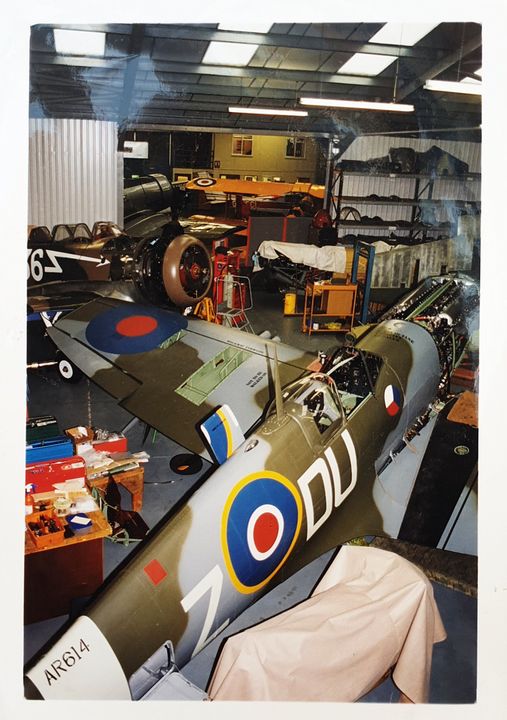
The two YAKs never flew together in Coventry’s ownership – probably a relief for the aurally-challenged citizens of Earls Colne! Two other early YAKs are associated with Earls Colne – neither of which have flown yet. A YAK 3 airframe was reportedly sourced from a Russian technical school and delivered to Earls Colne in July 1994 (32). The YAK 3 was the in-line engined fighter version, the design of which was subsequently modified to become the radial-engined YAK 11. This particular airframe appears to have been stored, possibly at Earls Colne, before crossing the Atlantic to Texas in 1996. Secondly, YAK 1 s/n 8188 spent some time under the ownership of the Historic Aircraft Collection at both Audley End and Earls Colne. It had been shot down by the Luftwaffe in December 1942 and force-landed on Polonets Lake in northern Russia. Recovered in October 1990, the hulk went to Audley End between 1992 and 1996 and to Earls Colne between 1999 and 2003 (32). Despite the ministrations of Hawker Restorations and the spending of a lot of money, the rebuild has not, to date, been completed. The YAK is registered G-BTZD and has been with Retrotec in Sussex since 2008.
The enthusiasm for YAKs at Earls Colne continued with new inspiration from Aero Anglia, a company formed by Dave and Jane Young in January 1999. Dave Young’s acquisition of Poplar Aviation Maintenance was designed to address a lack of light aviation maintenance facilities in NE Essex. The company was then motivated to become an importer of YAK 52 primary trainers. Since the nineties, the market for this robust, cheap, thoroughly aerobatic two-seater has been dominated by two companies: YAK UK at Little Gransden and Richard Goode Aerobatics of Herefordshire (indeed, the former reports that it has sold some 120 YAK 52s since 1992). Nonetheless, Aero Anglia decided to import YAK 52 G-BXJB in June 1997 and Dave Young remained a part-owner until 2008. It was registered to the YAK display group in September 2011 and retained its link with Earls Colne when it was sold to Bulldog Aviation in September 2019. Aero Anglia went on to become part of the Colne Valley Group whose activities are based at Earls Colne, but maintains workshops at Elmsett. This Suffolk airstrip is some 30 miles north-east of Earls Colne and is also the current home of Hawker Restorations.
(32) Information from Geoff Goodall’s Warbirds directory.
Hawker Restorations, as their name implies, is probably the World’s foremost restorer of Hawker Hurricanes. Although much workshop work was initially carried-out at Moat Farm, Milden, near Ipswich and is currently carried-out at Elmsett, many of the past successes have either had restoration work done at Earls Colne or had their first flight from there. Formed in 1987 as AJD Engineering, the Company chose to specialise in Hurricanes in 1993 while working in partnership with warbird collector Sir Tim Wallis on the restoration of his Hurricane P3351. The Company has since accumulated the necessary jigs, tools and expertise to become the go-to restorer for Hurricanes and, to date, they have completed restorations of at least ten of the fighters.
Their first Hurricane project, P3351, had been built as a Mk 1 but upgraded to a Mk IIa, given the new serial DR393 and, in spring 1942, sent to Russia. Shot down near Murmansk in winter 1943, she was recovered fifty years later and subsequently delivered to Tim Wallis. Restoration work by Hawker Restorations included new wings built by Airframe Assemblies at Sandown on the Isle of Wight. When completed, the Hurricane was shipped to New Zealand where she made her first flight on January 12th 2000.
G-TWTD was the second Hurricane rebuilt by the newly-formed Hawker Restorations and featured the initials of co-conspirators Tim Wallis and Tony Ditheridge. Once again, the work on the wings was completed on the Isle of Wight by Airframe Assemblies before assembly at Earls Colne and a first flight from the airstrip on June 7th 2000. Originally built in Canada as AE977, the Mk 1 had served with the Fleet Air Arm until crashing after a mid-air collision in December 1942. Written-off as being beyond repair, the remains were only recovered in 1960, reportedly stored in a shed for many years and only purchased by Hawker Restorations in 1994. Once in flying condition, G-TWTD didn’t spend long at Earls Colne as she was sold in the USA in 2001 and delivered to Chino, California. The Hurricane returned to the UK in 2012 and currently flies with Biggin Hill’s Heritage Hangar.
It is hard to give a complete summary of how many Hurricanes and Spitfires have been restored at Earls Colne as, in many cases, work has also been carried out at the other sites: Audley End, Milden and Elmsett. Today, a great deal of restoration work has moved to Duxford. Some aircraft which have graced the workshops/ airstrip at Earls Colne include:
Hurricane G-HURY. This aircraft was restored by Hawker at Milden and first flown from Earls Colne on 25th April 2003. It also had an interesting operational history: used by the RAF in Palestine in 1946 with the serial KZ321, the fuselage was located in Jaffa, Israel, in 1985. Registered G-HURY on 31st March 1989 to Doug Arnold, the Hurricane passed to The Fighter Collection/ Patina Ltd on April 25th 1991 prior to restoration at Milden. Following the rebuild, It was sold in Canada in 2006, returning to Europe as OO-HUR in 2018. The Hurricane was based at Brasschaat Airfield near Antwerp in Belgium until being sold in the Czech Republic in 2021. Tragically, the aircraft was lost following a low-level stall during an air show routine in August 2022. The pilot, Petr Paces, was killed.
Hawker Restoration also took on a project for the USA’s Wright-Patterson Museum. The National Museum of the US Air Force had a Hurricane replica – it had reputedly been produced by stitching together parts of five incomplete Hurricanes around a non-original skeleton during the 1980s. Received at Earls Colne in early 2001, Hawker Restoration rebuilt it as authentically as possible using non-airworthy components from other airframes. It was returned to the Wright Patterson in August 2002, painted as RCAF Hurricane Z3174.
Spitfire Vc AR614/ G-BUWA had spent time as a gate guardian in the UK before traveling to Canada in the 1960s for restoration. Still not airworthy, the Spitfire was sold to Ray Hanna’s Old Flying Machine Company at Duxford on 19th March 1993. Registered G-BUWA, it passed to Classic Aviation, nominally of Tortola, British Virgin Islands and/ or Switzerland on a couple of months later on May 11th. Rebuilt between 1994 and 1996 at the Audley End facility of Historic Flying Ltd, G-BUWA was first flown on 5th October 1996. She also spent time with Vintage Fabrics at Earls Colne where a further repaint as AR614 took place before the Spitfire went to Paul Allen’s Flying heritage and Combat Armor Museum in the USA in 1999.
Aircraft which had been flown by Spitfire enthusiasts Nick and Carolyn Grace also spent some time at Earls Colne – Carolyn lived close to the airfield at ‘The Cangle’, Halstead, for some years until 2015. Ex-Irish Air Corps Spitfires IAC 162/ ML407 (more of that one later) and IAC 161/ PV202 had been acquired by Nick Grace from the Strathallan Collection in 1979. After a slow rebuild, PV202 took to the air from Dunsfold in February 1990. She was operated from Goodwood as a 2-seater by Rick Roberts between 1991 and 1999 and, during this period, suffered an undercarriage incident which led to repairs being carried-out at Earls Colne. A fatal crash at Goodwood on 8th April 2000 unfortunately took the lives of occupants Greg McCurrach and Norman Lees. The Spitfire has, however, been reconstructed to flying condition by Historic Flying Ltd. Carolyn Grace was also associated with Seafire III PP972 which spent some time at Vintage Fabrics Earls Colne workshop. Delivered to the Aeronavale in 1948, she was deployed to Indo China before being pensioned-off as a technical airframe in 1949. Rescued from a French scrap yard, she was restored for static display at the Musee de la Resistance before being acquired by Doug Arnold’s Warbirds of Great Britain in 1988. Several restorers worked on PP972 from workshops at Thruxton and East Midlands (33). With the aircraft now owned through David Arnold’s Channel Island companies, work was moved to Earls Colne (Vintage Fabrics and Hawker Restorations) between 1996 and 2001. A number of faults were found with the earlier renovation work and these proved deamnding to rectify. The Seafire moved on to other restoration workshops and finally returned to the air on June 15th 2015 as G-BUAR. At the controls for the first flight was Nick and Carolyn’s son, Richard Grace, a pilot who had obtained his flying licence at Earls Colne in 2003 (34).
(33) Much individual aircraft history from www.warbirdregistry.org.
(34) See the excellent interview with Richard Grace in www.vintageaviationecho.com, 31st January 2021.
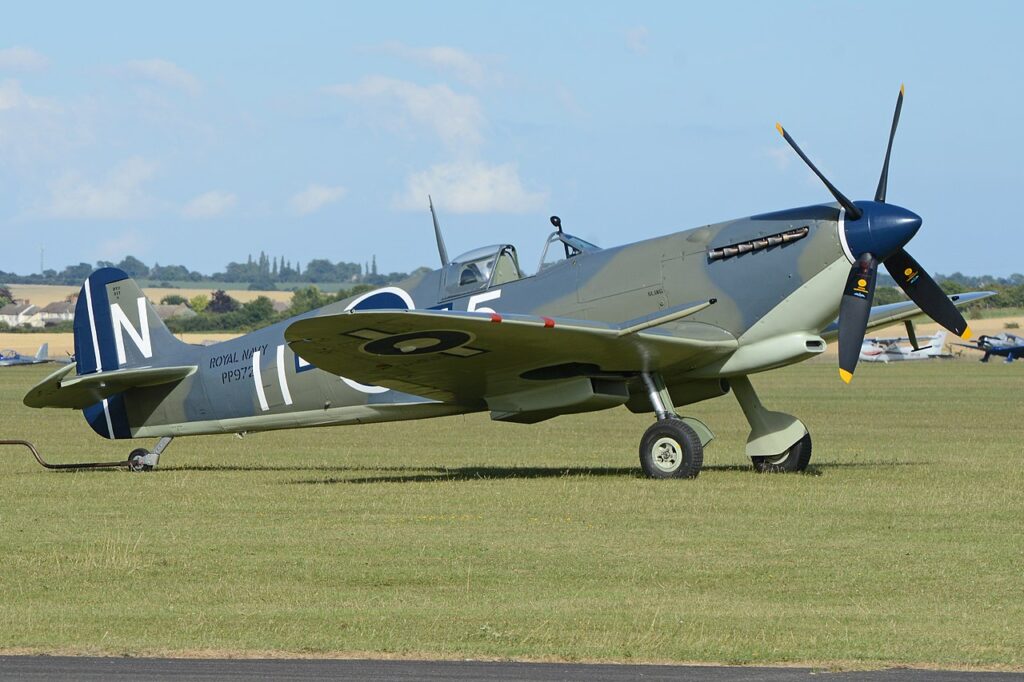
The exotic WW2 aircraft being restored at Earls Colne acted as a magnet for other exciting visitors in recent years – Steve Knight observes on his Flikr Account that he was able to photograph Pitts Special G-PIII, Beech Staggerwing N833CH and the Boeing Stearman N38940 all on the afternoon of March 30th 2021. But how did regular use of the airfield develop during the new millenium?
As mentioned, under the leadership of Mick Manders, Bulldog Aviation of the early eighties had been supplemented by the Essex Flying School as from March 1988. The Anglian Flight Centre was formed at Earls Colne on 24th December 1996 and, as from early 1999, Aero Anglia was formed to offer maintenance facilities. A major step forwards followed in 2002 when the runway gained a 778m asphalt insert. The strip was re-aligned from the 07/ 25 of RAF days to 06/ 24 and the 939m grass runway with its all-weather insert also gained asphalt taxiways and extra aircraft parking. Bulldog Aviation remained the operator and fuel, hangar and maintenance facilities were upgraded. Provision of aeronautical engineering facilities grew with the creation of Cavendish Aviation in June 2005. The new enterprise was spun out of Cavendish Engineers which had been formed in 1995. A similar boost to the airfield’s development followed with the participation of the Colne Valley Group. Initially electrical contractors, Colne Valley created subsidiaries dealing with mechanical projects and, on February 17th 2017, Colne Valley Aviation was formed with 75% of the shares held by Colne Valley Electrical. Kevin Barber, director of the latter, went on to obtain his Instrument Rating at Anglian Flight Centres. He also became a director of Bulldog Aviation and Anglian Flight Centres when the two businesses were incorporated into the Colne Valley Group in September 2017. This coincided with Mick Manders taking less of a role with Earls Colne operations. He celebrated his quieter life by taking a flight in ‘The Grace Spitfire’ ML407 from Earls Colne on 26th September 2017. By this time, Richard Grace was operating ML407 from Sywell, but the Spitfire returned to Colne to embark Mick Manders for a flight down to the established flying and aerobatics zone off Beachy Head. Returning northwards, the Spitfire cruised around in the vicinity of Birch airfield before landing back at Colne. The U-tube video of the flight shows just how much the Earls Colne strip had developed since the 1970s: hangars and workshops had moved along with the parking area to the western end of 06/ 24 and trees and vegetation now lined the grass/ tarmac strip and taxiways.
The importance of historic aviation expanded the following year when Kevin Barber expanded Anglian Flight Centres to create Anglian Warbirds in July 2018. The operation currently offers the chance to fly in either a Harvard or a Boeing Stearman from the vintage fleet or a Slingsby Firefly.
Aero Anglia joined the Colne Valley Group in February 2020 with the various constituent companies organised as Colne Valley Aviation Holdings at the end of 2019.
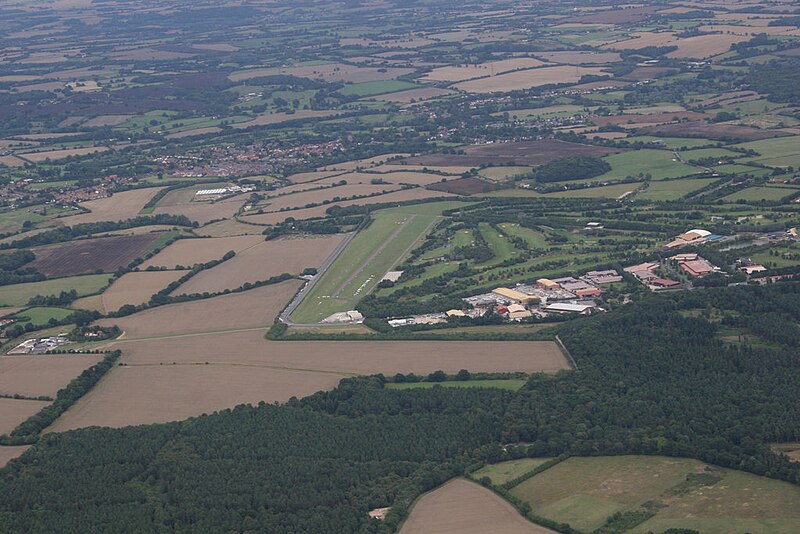
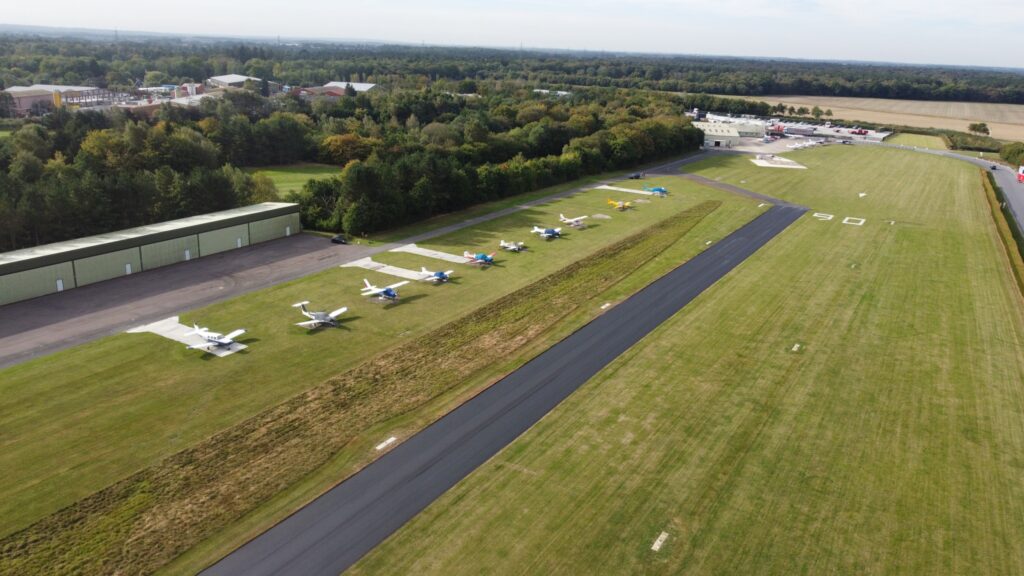
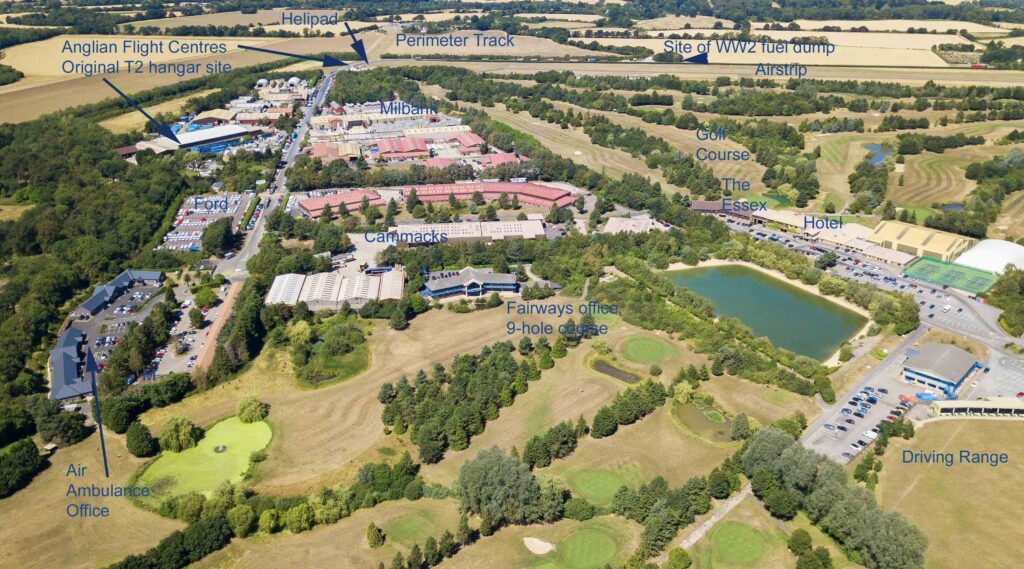
ESSEX AIR AMBULANCE
An important resident in recent years has been the Essex Air Ambulance, a privately funded organisation which was founded in 1997 and started operations in July 1998 from Boreham. The administration was originally managed from Broomfield Hospital in Chelmsford but the six staff moved to Earls Colne Business Park in 2004. During April 2007 the charity was reorganised as the Essex and Hertfordshire Air Ambulance Trust with the expansion of their service to cover Hertfordshire. A second helicopter was added on November 5th to cover Hertfordshire and this was sprayed red in contrast to the Essex helicopter’s yellow scheme. While the original Essex Bolkow B105 (and subsequently Eurocopter EC135) helicopters had been leased from Bond, the Hertfordshire MD900 was leased from Specialist Aviation Services of Staverton. The paramedic side of the operation was crewed by the East of England Ambulance Service Trust and, in 2008, doctors were added to the helicopter crews. These were supplied by the Mid-Essex Hospital NHS trust.
In April 2011 the Essex helicopter’s operational base was moved from Boreham to Earls Colne. In view of the geographical areas of operation, the Hertfordshire helicopter is now based at North Weald. A dedicated operational base incorporating a training and visitor centre was completed in 2021. AW169 G-HHEM is based at North Weald and is the first helicopter owned, rather than leased, by EHAAT. During the hours of darkness and spells of bad weather, helicopter service is replaced by a rapid response ambulance based at North Weald. While the Earls Colne centre is less glitzy than North Weald, it remains the organisation’s base and the Essex helicopter based there will soon be upgraded to an EHAAT-owned Leonardo AW169 as well.
Helicopters Operated by EHAAT (details from the CAA’s G-INFO site):
G-ESAM Bolkow Bo105D, 1998 to 2003, leased from Bond.
G-SSXX Eurocopter EC135, 2003 to 2010, leased from Bond.
G-HAAT MD900, 2008 – 2017, leased from Specialist Aviation Services
G-EHAA MD900, 2010 – 2017, leased from Specialist Aviation Services
G-HHEM AW169, 2017 to date, owned by EHAAT.
G-EHEM, MD902, 2017- 29/2/2024, leased Specialist Avn Services
An interim A109 will be replaced by an EHAAT-owned AW169 for the Essex operation later into Spring 2024.
The Essex and Hertfordshire Air Ambulance has received major support from the Hobbs family at Earls Colne and continues to be almost completely privately funded. In 2023, 2705 missions were flown at an average cost of 2200 pounds each – which seems quite reasonable for helicopter operation. The missions included 1105 medical emergencies, 549 Road Traffic Accidents and 427 accidental injuries (35).
(35) Figures from the EHAAT website.
HERITAGE:
The airfield’s USAAF heritage has always been well-documented, the RAF history less so. The ‘Bird in Hand’ Pub on Coggeshall Road, close to the south-eastern end of runway 12/30, had several photos of 323rd BG B-26s on the walls. The memory of the crews who drank there was also maintained by the occasional visit of 323rd veterans.
Eric Hobbs Sports and Leisure Centre on the airfield also displayed a selection of paintings of WW2 operations on the walls and, again, the USAAF featured prominently. At the beginning of May 1992, the B-26 Marauder Historical Society arranged for the ‘Return of the Marauder Men’ tour of East Anglia and the Continent to commemorate the fiftieth anniversary of the first American Air Force aircraft arriving in the UK. Their first day was spent at County Hall in Chelmsford for a civic commemoration. The following day, the Marauder Men visited Duxford before veterans of 323rd BG visited Earls Colne. They were impressed both that the Stars and Stripes was flying from the Church flagpole and in the number of villagers who turned-out to welcome them. After a brief tour of past-favourite pubs, Technical Sgt Casimier Sochocki planted a commemorative tree in front of St.Andrews church (36). The veterans were then escorted to the Rebel Air Museum on the airfield by a guard of honour dressed in US uniforms and driving WW2 American military vehicles. After unveiling exhibits at the Museum and watching a spirited 10-minute air display flown by rock musician Gary Numan in Eddie Coventry’s YAK, the Marauder Men joined Eric Hobbs at the Country Club for tea. Yet more dining was in store for them in Coggeshall where the town hall was packed-out by local people. On the third and final day of their visit to England, a Sunday, the group visited the American Cemetery at Cambridge where there was a flypast to commemorate members of the Ninth Air Force who never returned home. A final send-off was provided in Colchester that night with a talk by military aviation expert Roger Freeman and dancing to a Glenn Miller style swing band.
Spool forward fifteen years to 2007 and a memorial was unveiled to the men of USAAF’s 94th and 323rd Bomb Groups and the RAF’s two 38 Group Halifax Squadrons.The dedication was read by Captain Michael Murphy of 100th Ops Group USAF, then based at Mildenhall, with a guard of honour provided by RAF Mildenhall. In attendance was 86-year old Bob Mims, a 26-mission veteran of 323rd Bomb Group operations. More recently, the uniform of Lt.Robert Ransom has been displayed at the Essex Golf Club on the airfield. As a 21-year old, Ransom flew B-26 ‘Hades Lady’ on a full fifty combat missions from Earls Colne and, probably, subsequently from RAF Beaulieu.
(36) Additional detail from the B-26 Marauder Historical Society monograph ‘Return of the Marauder Men’.
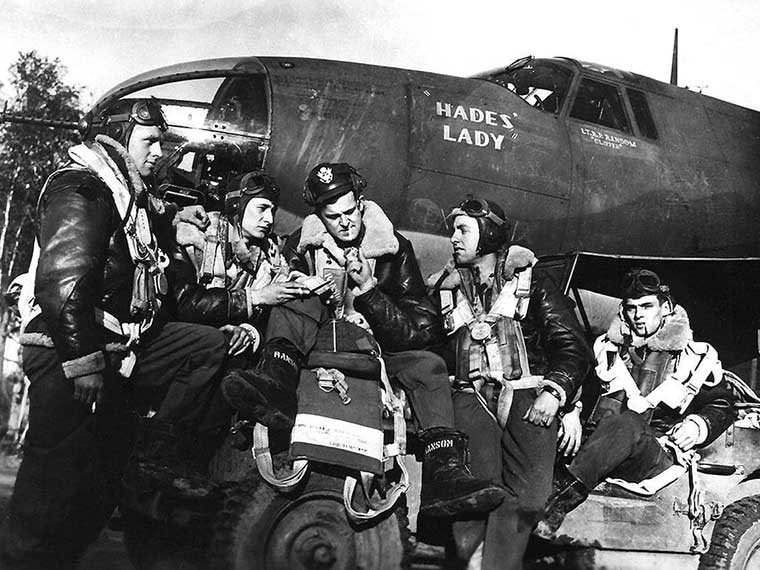
In the late 1980s, Earls Colne airfield also hosted a well-known heritage organisation – the Rebel Air Museum. The RAM had been formed originally by father and son Stan and David Brett at the fellow-Marauder operating base of Andrews Field, Great Saling, on the opposite side of Braintree. The two Bretts had a long-established and diverse interest in aircraft preservation and had worked with both the Essex Aviation Group at Duxford and the Historic Air Museum at Southend. Their main interest at the HAM had been the B-25 Mitchell N9089Z, previously well-known as the photo ship during the filming of ‘The War Lover’ and ‘The Battle of Britain’. Their interest in USAAF medium bombers extended to the B-26 Marauder and, upon the somewhat controversial break up of the Southend museum, they established the Rebel Air Museum at the Andrews Field airstrip owned by farmer Clive Harvey. Their facilities were very limited but the Museum was able to exhibit in a blister hanger on weekends – but were then obliged to dismantle everything again for the working week! There was also a diorama of 322nd BG aircraft on dispersal and a large collection of photographs was built-up documenting both the 322nd and 323rd Bomb Groups. Stan Brett died in 1986 and the museum went into hiatus for a couple of years (37). Eventually, the RAM moved to Earls Colne where exhiits were initially stored in some rather tired caravans. A benefactor of the Museum lent sufficient capital for the construction of 7000 sq. ft. display room which was built by the members in 1989. Encouraged by their past home at 322nd BG’s Andrews Field base and their current home on 323rd BG’s home airfield, the RAM began to feature Martin Marauder history with the Eighth and Ninth Air Forces. This, in turn, encouraged visits from the Ninth Air Force veterans who brought many photos and stories with them. The RAM also manage to acquire substantial sections of B-26 42-35253, Mr Shorty, which made its way to them via a scrapyard near Warrington in Cheshire, the RAF Burtonwood Association and the Duxford Aviation Group (38). While the museum concentrated on USAAF artifacts, it also exhibited a loaned ‘Pou de Ciel’, an ex-Southend Air Museum Fairchild Cornell and a section of a replica Hurricane from the ‘Battle of Britain’ film. The Museum’s previously-displayed Dassault Mystere IVa remained at Andrews Field. There was also a collection of WW2 military vehicles which was housed at the old fuel dump area adjacent to Coggeshall Road (39). Although a keen band of enthusiasts supported the Rebel Air Museum (and the Bird in Hand pub), the untimely death of Dave Brett in 1994 saw the group begin to flounder and it closed its doors in 1997. The B-26 fuselage section went to Markshall Estate and, subsequently, to the museum on the old airfield at Boxted – another ex-Marauder base.
(37) From ‘Vampires and Fleas’ by Alec Brew, pub. by the Crowood Press, 2003.
(38) 454th Bomb Squadron, 323rd BG Newsletter, ‘The Wolf Howl-l-l’ , Spring 2011. ‘Mr Shorty/ Black Magic IV’ B-26 42-35253 carried the identity RJ-S and was piloted on June 1944 missions by Lt.Howard Jenks. The first mission was to hit the rail road bridge at Cherisy in France. By the end of the war in Europe this B-26 had completed 96 missions, the last being an attack on an ME262 airfield on 25th April 1945, flown by Lt.Dick Gray. While many B-26s were cut-up for scrap at Landsberg, Germany, ‘Mr Shorty’ and some other 323rd B-26s made it back to Burtonwood, Merseyside, where the remains were subsequently discovered in 1974.
(39) These were probably the vehicles which escorted ‘The Marauder Men’ veterans in 1992. I have often wondered what happened to the ex-US military trucks which were used for logging in the Markshall/ Nunty’s Wood during the late sixties; perhaps they joined this collection?
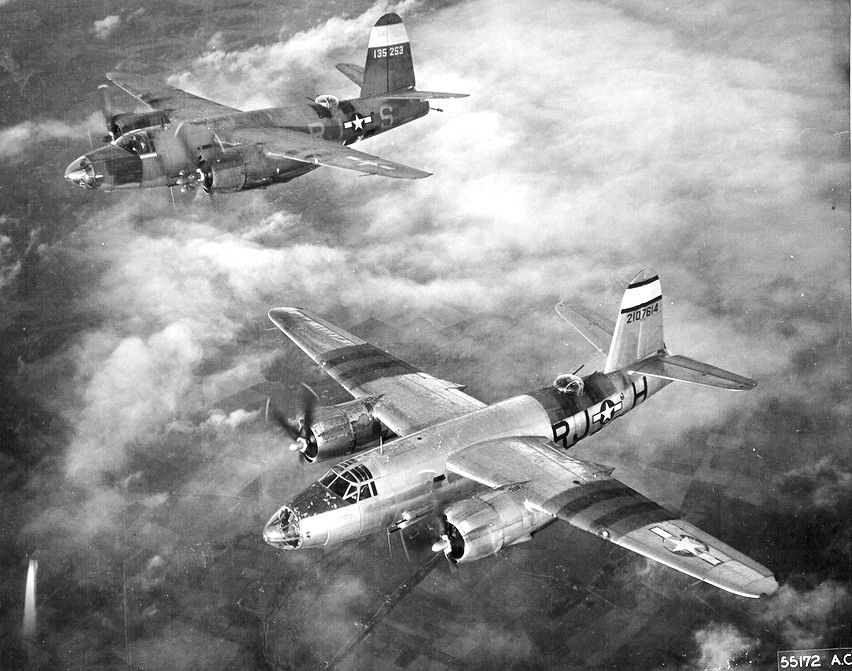
FINAL WORD
The Markshall and Honeywood estates have always been an important part of the history of the Colne Valley from the Domesday Book onwards. The Second World War wrought large changes in the area with the building of Earls Colne airfield to accommodate, initially, our allies, the United States Army Air Force, and, subsequently, squadrons of 38 Group Royal Air Force. The USAAF presence is well-remembered although it was quite brief – in the case of 94th Bomb Group Flying Fortresses only a few weeks and a very few missions. The B-26 Marauders of 323rd Bomb Group have not been fondly remembered by aviation history but their stay at Earls Colne has always been one of the most charismatic episodes in the airfield’s history. The two RAF squadrons based at Earls Colne also contributed greatly but have been less discussed in history. They took part in the largest aerial invasion that the World has ever seen towing gliders to cross the Rhine on the final push to destroy Nazi Germany. Indeed, the only woman to have flown on Operation Varsity took to the air from Earls Colne. The two Halifax squadrons also flew missions to support the French, Dutch and Norwegian resistance as well as the brave men and women of the SOE. These missions demanded great navigational skill as, usually, single bombers flew lonely, long-range missions across a darkened Europe. At the end of the war, the two RAF squadrons flew missions to recover ex-Prisoners of War and were also the pioneers of long range air mail and courier flights from Britain to India. The allied squadrons based at Earls Colne suffered many losses both in action and during training and general flying. The 94th’s Fortresses suffered particularly badly on their final mission from Earls Colne as they returned across the North Sea to their new home at Rougham. The 323rd BG also suffered losses (40), but maybe not as many as could be expected: their maligned medium-range Marauders actually looked after them quite well as did the extensive fighter cover provided by the USAAF and the RAF. The Halifaxes of 296 and 297 Squadrons also suffered losses due to enemy action and the many technical problems which affected military aviation in the 1940s, less than half a century after Wilbur Wright’s first powered flight at Kittyhawk.
Looking back now, some eighty years, it is hard to imagine the changes that this must all have created in local life. Aerial photographs show the scars created in the local pastoral landscape by the building of the long concrete runways, two vast hangars and the large spread of accommodation scattered through Markshall woods. Much of this has disappeared, but the occasional section of concrete road in Markshall woods, and further afield in Monks Wood, Witches Wood, indicate the huge network created for the air force operation. Additionally, the logistics of delivering fuel, bombs and supplies would have hugely affected the local road and rail networks. The Colne Valley railway has long gone but many minor roads out behind Wakes Colne and Colne Engaine still appear to be rather wider than expected – an indication of work done to accommodate the large American trucks supplying the East Anglian airfields with bombs and munitions.
Since the War, the airfield has been returned to a peaceful, rural landscape although new functions such as light industry, warehousing and recreation have largely replaced the agrarian land use. Civil aviation has not just returned but has thrived. Private flying, instruction, heritage engineering and the provision of parking and maintenance facilities have all thrived and look set to develop into the future. The Hobbs Estate has preserved the military heritage of the airfield while adding to both village employment and community functions. An area of land has been assigned for allotments, the Coggeshall Colts cricket club play matches on a new green and the School of Advanced Motorists regularly uses estate roads to train young drivers. It is probably fair to say that during the fifties, sixties and seventies, hundreds of young drivers practiced driving skills with harassed parents around the airfield perimeter track, so it is good to see that this tradition has been maintained and developed. The aerial landscape of the 2020s is shown below in the series of pictures provided by the Hobbs Estate. It is sure to continue to evolve….
(40) ‘The Return of the Marauder Men’ gives a breakdown of 323rd BG personnel who gave their lives during WW2 and are buried in Britain and Europe. Fourteen airmen are buried at the Cambridge American Cemetery with a further fourteen commemorated as missing. Across Europe, a further thirty-three are buried in eight cemeteries and twenty commemorated as missing.
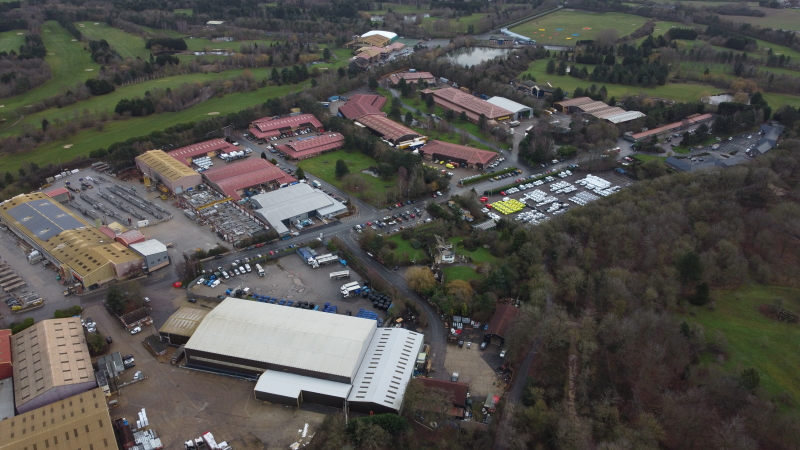
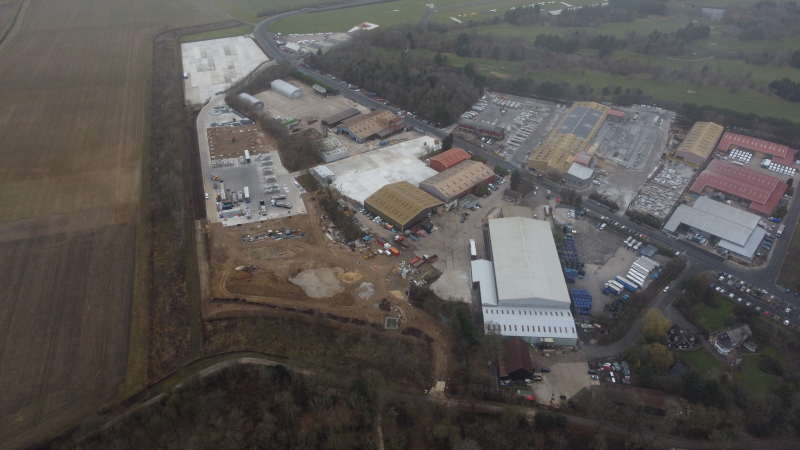
Hits: 180
